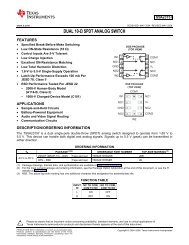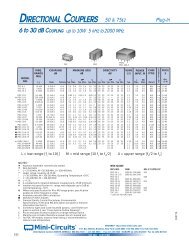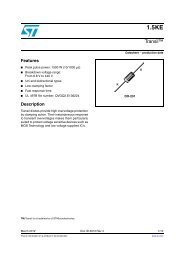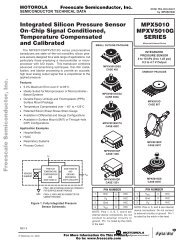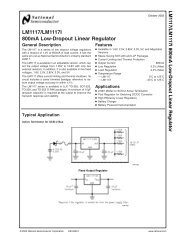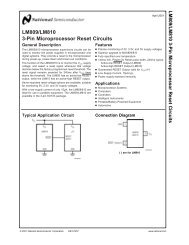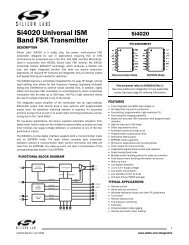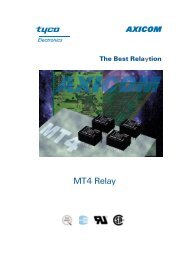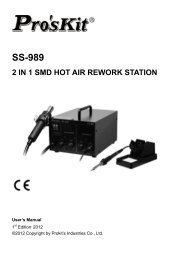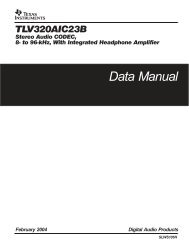LM3445 Triac Dimmable Offline LED Driver
LM3445 Triac Dimmable Offline LED Driver
LM3445 Triac Dimmable Offline LED Driver
You also want an ePaper? Increase the reach of your titles
YUMPU automatically turns print PDFs into web optimized ePapers that Google loves.
<strong>LM3445</strong><br />
The valley-fill circuit allows the buck regulator to draw power<br />
throughout a larger portion of the AC line. This allows the capacitance<br />
needed at V BUCK to be lower than if there were no<br />
valley-fill circuit, and adds passive power factor correction<br />
(PFC) to the application. Besides better power factor correction,<br />
a valley-fill circuit allows the buck converter to operate<br />
while separate circuitry translates the dimming information.<br />
This allows for dimming that isn’t subject to 120Hz flicker that<br />
can be perceived by the human eye.<br />
VALLEY-FILL OPERATION<br />
When the “input line is high”, power is derived directly through<br />
D3. The term “input line is high” can be explained as follows.<br />
The valley-fill circuit charges capacitors C7 and C9 in series<br />
(see figure 9) when the input line is high.<br />
30060319<br />
FIGURE 9. Two stage Valley-Fill Circuit when AC Line is<br />
High<br />
A three stage valley-fill circuit performs exactly the same as<br />
two-stage valley-fill circuit except now three capacitors are<br />
now charged in series, and when the line voltage decreases<br />
to:<br />
Diode D3 is reversed biased and three capacitors are in parallel<br />
to each other.<br />
The valley-fill circuit can be optimized for power factor, voltage<br />
hold up and overall application size and cost. The<br />
<strong>LM3445</strong> will operate with a single stage or a three stage valley-fill<br />
circuit as well. Resistor R8 functions as a current<br />
limiting resistor during start-up, and during the transition from<br />
series to parallel connection. Resistors R6 and R7 are 1 MΩ<br />
bleeder resistors, and may or may not be necessary for each<br />
application.<br />
BUCK CONVERTER<br />
The <strong>LM3445</strong> is a buck controller that uses a proprietary constant<br />
off-time method to maintain constant current through a<br />
string of <strong>LED</strong>s. While transistor Q2 is on, current ramps up<br />
through the inductor and <strong>LED</strong> string. A resistor R3 senses this<br />
current and this voltage is compared to the reference voltage<br />
at FLTR2. When this sensed voltage is equal to the reference<br />
voltage, transistor Q2 is turned off and diode D10 conducts<br />
the current through the inductor and <strong>LED</strong>s. Capacitor C12<br />
eliminates most of the ripple current seen in the inductor. Resistor<br />
R4, capacitor C11, and transistor Q3 provide a linear<br />
current ramp that sets the constant off-time for a given output<br />
voltage.<br />
The peak voltage of a two stage valley-fill capacitor is:<br />
As the AC line decreases from its peak value every cycle,<br />
there will be a point where the voltage magnitude of the AC<br />
line is equal to the voltage that each capacitor is charged. At<br />
this point diode D3 becomes reversed biased, and the capacitors<br />
are placed in parallel to each other (figure 10), and<br />
V BUCK equals the capacitor voltage.<br />
30060321<br />
FIGURE 10. Two stage Valley-Fill Circuit when AC Line is<br />
Low<br />
www.national.com 12



